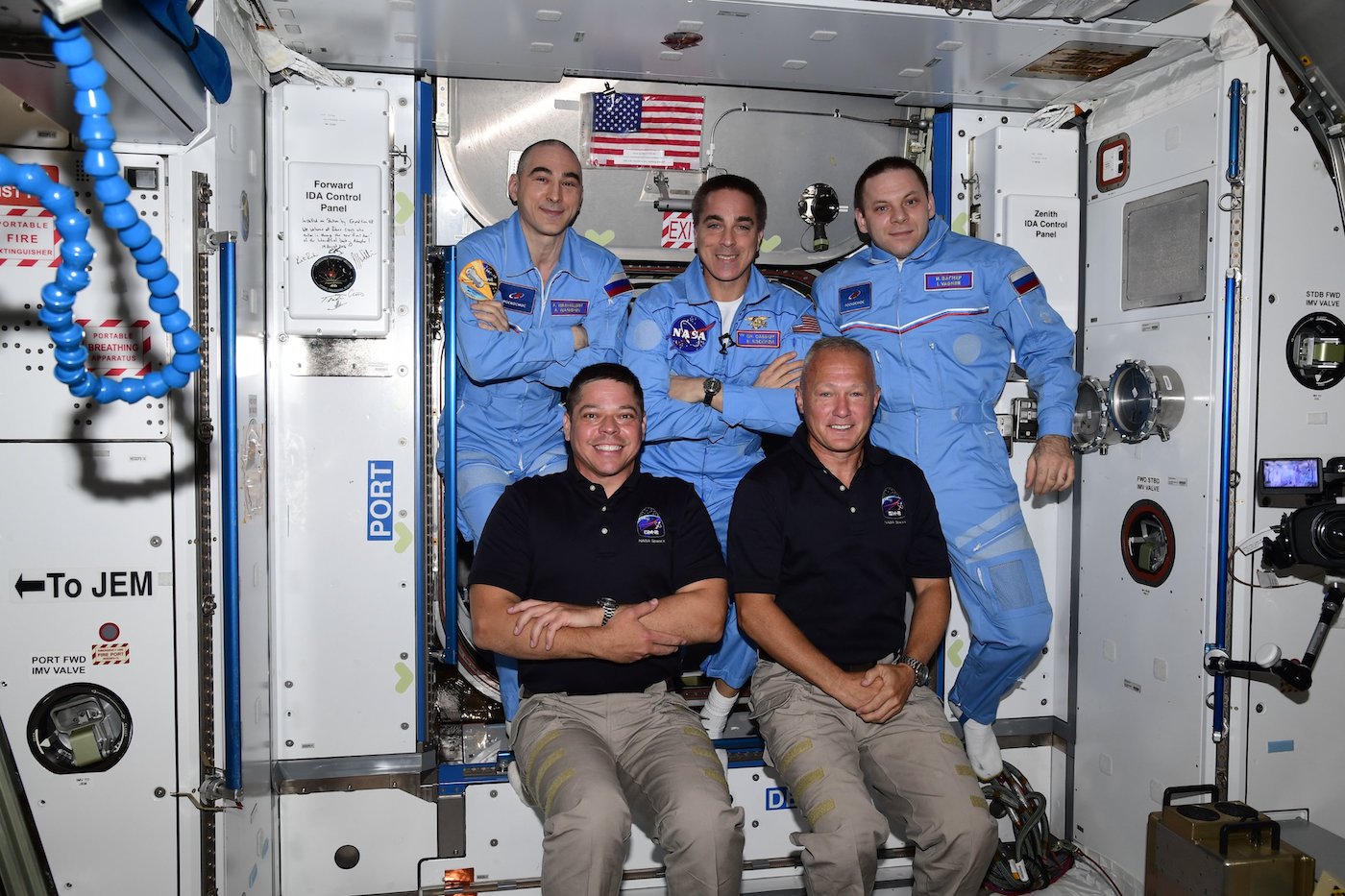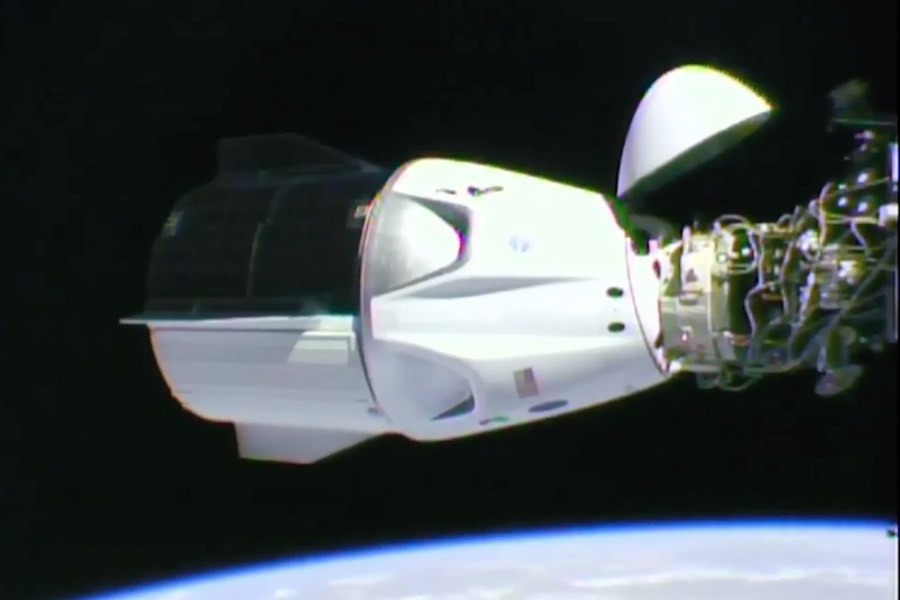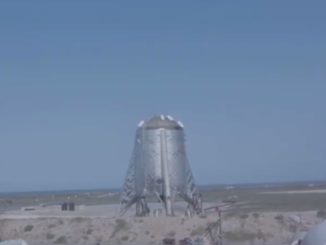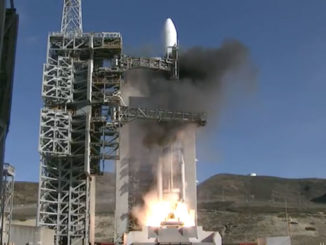
A Crew Dragon spaceship built and owned by SpaceX glided to an automated docking with the International Space Station Sunday, delivering NASA astronauts Doug Hurley and Bob Behnken to the orbiting research complex after a trouble-free 19-hour flight from the Kennedy Space Center.
The gumdrop-shaped capsule, named Endeavour by Hurley and Behnken in honor of NASA’s retired space shuttle, linked up with a docking adapter on the space station’s Harmony module at 10:16 a.m. EDT (1416 GMT) Sunday. Running a few minutes early, the crew capsule docked in autopilot mode after Hurley tested the ship’s manual touchscreen flight controls on its approach to the space station.
The docking marked the first time a commercial spacecraft has carried astronauts to the International Space Station, a landmark accomplishment for NASA as the U.S. space agency looks to commercialize transportation to and from Earth orbit.
The Dragon crew capsule launched atop a SpaceX Falcon 9 rocket at 3:22 p.m. EDT (1922 GMT) Saturday from pad 39A at the Kennedy Space Center. It was the first crew flight on SpaceX’s Falcon 9 rocket after 84 flights of SpaceX’s workhorse launcher.
A few minutes after the initial contact, the docking ring retracted and 12 hooks closed to make a firm connection between the Dragon spacecraft and the space station. A set of power and data umbilicals also mated through the docking adapter to route electricity and communications between the station and Crew Dragon.

Mission control radioed the Dragon crew at the conclusion of the automated docking sequence.
“We copy, docking complete,” Hurley said. “It’s been a real honor to be just a small part of this nine-year endeavor since the last time a United States (crew) spaceship has docked with the International Space Station.
“We have to congratulate the men and women of SpaceX at Hawthorne, McGregor and at Kennedy Space Center for incredible efforts over the last several years to make this possible,” he said. “It cannot go overstated.”
Hurley also thanked engineers from NASA’s commercial crew program, which has overseen development of SpaceX’s Crew Dragon spacecraft and Boeing’s Starliner crew capsule, which has not yet flown in space with astronauts.
“This is an incredible time to be at NASA (with) three new vehicles to be flown continuing the mission in low Earth orbit, and then to the moon and Mars,” Hurley said, referring to the Dragon, Starliner and NASA’s Orion capsule designed for trips farther from Earth.
Here’s a replay of the Crew Dragon’s automated docking with the International Space Station at 10:16am EDT (1416 GMT).
SpaceX’s crew capsule became the first commercial spaceship to deliver astronauts to the space station.
LIVE COVERAGE: https://t.co/1DF5tRjUzj pic.twitter.com/fQpGBFLP0I
— Spaceflight Now (@SpaceflightNow) May 31, 2020
Chris Cassidy, commander of the space station’s Expedition 63 crew, rang the ship’s bell to welcome the SpaceX crew capsule.
“Dragon, arriving,” Cassidy said. “The crew of Expedition 63 is honored to welcome Dragon and the commercial crew program … aboard the International Space Station. Bob and Doug, glad to have you part of the crew.”
After a series of pressure and leak checks in the passageway between the Dragon and the space station, the astronauts opened hatches between the vehicles, and Hurley and Behnken floated into the nearly 500-ton research complex in a scene reminiscent of the arrivals of visiting space shuttle crews during the station’s construction.
Cassidy was the only U.S. astronaut on the space station before the Crew Dragon docking. He launched April 9 from Kazakhstan aboard a Soyuz spacecraft with Russian crewmates Anatoly Ivanishin and Ivan Vagner.
After exchanging hugs and greetings, the combined five-person crew marked the occasion with a live video downlink with VIPs gathered at NASA’s mission control center in Houston.
Hurley and Behnken’s mission — designated Demo-2, or DM-2 — is a test flight to check the performance of the Crew Dragon spacecraft before its pressed into operational service later this year. The SpaceX crew capsule, along with Boeing’s Starliner, will carry astronauts to and from the station on regular crew rotation flights lasting up to 210 days.
“While we’re on-board the space station with a new spacecraft, we do hope to put her through her paces,” Behnken said after entering the space station Sunday. “So the good ship Endeavour is going to get a lot of checkout over the next week or two here, and hopefully we will be able to declare her operational.”
“As SpaceX’s final flight test, it will validate all aspects of its crew transportation system, including the Crew Dragon spacecraft, spacesuits, Falcon 9 launch vehicle, launch pad 39A and operations capabilities,” NASA said in a statement summarizing the Demo-2 mission objectives.
But the two Dragon astronauts — each veterans of two prior space shuttle missions — will be part of the space station’s Expedition 63 crew for a period of one-to-four months, NASA officials said before the launch.
Dragon astronauts Doug Hurley and Bob Behnken have floated into the space station’s Harmony module to join commander Chris Cassidy and Russian flight engineers Anatoly Ivanishin and Ivan Vagner. https://t.co/1DF5tRjUzj pic.twitter.com/2h75iYwu1O
— Spaceflight Now (@SpaceflightNow) May 31, 2020
Behnken, the Demo-2 mission’s joint operations commander, is expected to perform multiple spacewalks with Cassidy in the coming weeks to install fresh lithium-ion batteries outside the space station. The new batteries arrived on an unpiloted Japanese HTV supply ship May 25.
Behnken and Cassidy might also conduct a spacewalk to focus on tasks outside the European Space Agency’s Columbus lab module.
“We’re looking forward to contributing any way that we can and trying to keep the space station as productive as possible,” Behnken said Sunday.
The Dragon crew was scheduled to get a safety briefing from Cassidy Sunday afternoon.
“Then we’re looking froward to some operational stuff later in the month,” Cassidy said. “Maybe we’ll get outside and do some spacewalks … We’re all super-excited to have two more crewmates on the Expedition 63 team.”
The historic mission to restore human spaceflight capability to U.S. shores comes amid the coronavirus pandemic and protests against racial injustice.
“As a country, we’re in the midst of a tough week,” said Sen. Ted Cruz, R-Texas. “We’re seeing protests. We’re seeing a lot of anger, we’re seeing violence. I have to say this launch, and y’all’s docking, is a powerful inspiration of what we can do when we come together — the power of unity, the power of ingenuity.”
“This is just one effort that we can show for the ages in this dark time that we’ve had over the past several months to kind of inspire especially the young people in the United States to reach for the lofty goals, and work hard and look what you can accomplish,” Hurley said.
Hurley, 53, is a retired Marine Corps colonel who hails from Upstate New York. Behnken is a 49-year-old Missouri native, and a colonel in the Air Force.
They are the first astronauts to fly commercial into Earth orbit. NASA says the change will bring about lower costs and more innovation in the space transportation industry.
NASA is also looking to incorporate commercial elements in its architecture to return humans to the lunar surface. The agency last month announced SpaceX and two other companies won contracts to advance development of human-rated lunar lander vehicles.
“This is the beginning,” said NASA Administrator Bridenstine. “We are now launching (astronauts) to low Earth orbit again, but we will soon be going to the moon. We will going to the moon sustainably with commercial partners and international partners. We are going to use the resources of the moon to learn how to live and work for long periods of time. Ultimately, we’re going to take all of that knowledge, and we’re going to go to Mars.”
The Demo-2 astronauts will live and work on the International Space Station for one-to-four months before coming back to Earth for a parachute-assisted splashdown in the Atlantic Ocean around 24 nautical miles off the east coast of Florida. The final duration of their test flight will be primarily determined by the performance of the capsule’s solar arrays in orbit, mission managers said earlier this month.
The test flight was originally slated to last only a week or two, but NASA approved a mission extension to ensure the space station’s U.S. segment is fully staffed to conduct experiments and stage spacewalks needed for maintenance and upgrades.
Astronaut Bob Behnken discusses the experience of riding SpaceX’s Falcon 9 rocket into space yesterday.
“Dragon was huffing and puffing all the way into orbit,” Behnken says.
WATCH LIVE: https://t.co/1DF5tRjUzj pic.twitter.com/xGdoeauBQK
— Spaceflight Now (@SpaceflightNow) May 31, 2020
NASA has paid the Russian government approximately $3.9 billion since 2006 to purchase Soyuz seats for astronauts from the United States and the station’s other international partners, according to a report last year by NASA’s inspector general.
Most recently, NASA agreed to pay the Russian government $90.2 million for a single Soyuz seat on a launch this October. The U.S. space agency decided to sign the agreement to guarantee access to the space station for a NASA crew member in the event of additional delays in the new U.S. crew capsules.
Assuming Hurley and Behnken’s test flight goes according to plan, the first operational Crew Dragon launch is scheduled from the Kennedy Space Center no earlier than Aug. 30 with a four-person space station crew.
Boeing’s Starliner spaceship — facing delays after a problem-plagued unpiloted test flight last December — will have to perform a second automated demonstration mission before it is cleared to fly astronauts. The Starliner’s crewed test flight to the space station is now expected in the first half of 2021.
The start of commercial crew transportation service will allow the space station crew size to increase from six to seven people. But with NASA seat purchases on the decline, Russia’s space agency has reduced the production rate for Soyuz spacecraft.
The slower Soyuz launch rate has limited the station crew to just three people until the Dragon test flight. That was a factor in NASA’s decision to extend the duration of Hurley and Behnken’s stay at the complex.
“We have had a tremendous partnership with Roscosmos (Russia’s space agency), and we will continue to do so, but it is nice to see crew arrive from this side of the space station after nine years,” said Mark Geyer, director of NASA’s Johnson Space Center in Houston.
A report by the NASA inspector general last year concluded the space agency is paying roughly $55 million per round-trip seat on Crew Dragon missions, and $90 million for a Starliner ticket to the space station. Both capsules will typically carry four astronauts on missions to the International Space Stations.
NASA expects to end payments to Russia once the new U.S. crew ships are operational. Under the space agencies’ current plans, U.S. astronauts will continue flying on Soyuz spacecraft and Russian cosmonauts will launch and land on the new U.S. vehicles under a barter arrangement, with no funds exchanged.
But Russian officials say they are not assigning cosmonauts to missions on U.S. vehicles until they are flight-proven.
Russia’s partnership with NASA on the International Space Station program on a technical level has been an unqualified success. Without Russian spacecraft, U.S. astronauts could have not flown to and from the station in the wake of the space shuttle Columbia accident in 2003, or since the shuttle’s retirement in 2011.
But the political relationship has been tortured at times.
One low point came in 2014, when Russia annexed Crimea. That prompted the Obama administration to levy U.S. sanctions on Russian government entities, and some individuals, including then-Russian deputy prime minister Dmitry Rogozin, who is now the head of Roscosmos, the Russian space agency.
In response to the sanctions, Rogozin suggested on Twitter in 2014 that the United States “deliver its astronauts to the ISS with a trampoline.”
“The trampoline is working,” joked Elon Musk, SpaceX’s founder and CEO, after Saturday’s launch of the Dragon spacecraft.
Email the author.
Follow Stephen Clark on Twitter: @StephenClark1.



